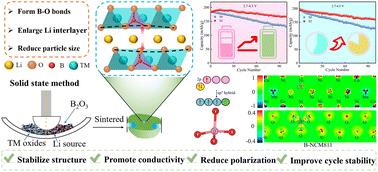Enhanced cycling performance of B-doped LiNi0.8Co0.1Mn0.1O2 cathodes prepared by the solid-state method
IF 10.7
2区 材料科学
Q1 CHEMISTRY, PHYSICAL
引用次数: 0
Abstract
LiNi0.8Co0.1Mn0.1O2 (NCM811) cathode material is widely used due to its high capacity and low cost but it shows poor cycle stability. It is well established that B3+ plays an active role in the charge–discharge cycle of high-Ni ternary cathodes. However, the role of B3+ in the cathode structure is rarely discussed. In this work, a simple and efficient solid-state method was used to prepare B-doped NCM811 samples. The results indicate that after 100 cycles at 1C, B-NCM811 exhibited excellent cycling stability with cycle retention rates of 90.7% and 81.3% over 2.7–4.3 V and 2.7–4.5 V, respectively. CV and EIS results indicate that B-doping effectively reduced charge transfer impedance and polarization, which was confirmed by DOS calculation results. Combined with DFT calculations, it was found that B3+ in the transition metal (TM) gap tends to bond with oxygen to form BO4 tetrahedra, and strong B–O bonds can improve structural stability. Moreover, B-doping increased the length of the Li–O bond, reducing the Li+ migration barrier. This study demonstrates that B-doping effectively enhances the structural stability of Ni-rich layered cathodes.

固态法制备的掺 B LiNi0.8Co0.1Mn0.1O2 阴极的更佳循环性能
LiNi0.8Co0.1Mn0.1O2 (NCM811) 阴极材料因其容量高、成本低而被广泛使用,但其循环稳定性较差。众所周知,B3+ 在高镍三元阴极的充放电循环中发挥着积极作用。然而,B3+ 在阴极结构中的作用却很少被讨论。在这项工作中,采用了一种简单高效的固态方法制备了掺杂 B 的 NCM811 样品。结果表明,在 1C 下循环 100 次后,B-NCM811 表现出优异的循环稳定性,在 2.7-4.3 V 和 2.7-4.5 V 下的循环保持率分别为 90.7% 和 81.3%。CV 和 EIS 结果表明,掺 B 有效地降低了电荷转移阻抗和极化,DOS 计算结果也证实了这一点。结合 DFT 计算发现,过渡金属(TM)间隙中的 B3+ 倾向于与氧键合形成 BO4 四面体,而强 B-O 键可以提高结构的稳定性。此外,B掺杂增加了Li-O键的长度,降低了Li+迁移障碍。这项研究表明,掺杂 B 能有效提高富镍层状阴极的结构稳定性。
本文章由计算机程序翻译,如有差异,请以英文原文为准。
求助全文
约1分钟内获得全文
求助全文
来源期刊

Journal of Materials Chemistry A
CHEMISTRY, PHYSICAL-ENERGY & FUELS
CiteScore
19.50
自引率
5.00%
发文量
1892
审稿时长
1.5 months
期刊介绍:
The Journal of Materials Chemistry A, B & C covers a wide range of high-quality studies in the field of materials chemistry, with each section focusing on specific applications of the materials studied. Journal of Materials Chemistry A emphasizes applications in energy and sustainability, including topics such as artificial photosynthesis, batteries, and fuel cells. Journal of Materials Chemistry B focuses on applications in biology and medicine, while Journal of Materials Chemistry C covers applications in optical, magnetic, and electronic devices. Example topic areas within the scope of Journal of Materials Chemistry A include catalysis, green/sustainable materials, sensors, and water treatment, among others.
 求助内容:
求助内容: 应助结果提醒方式:
应助结果提醒方式:


